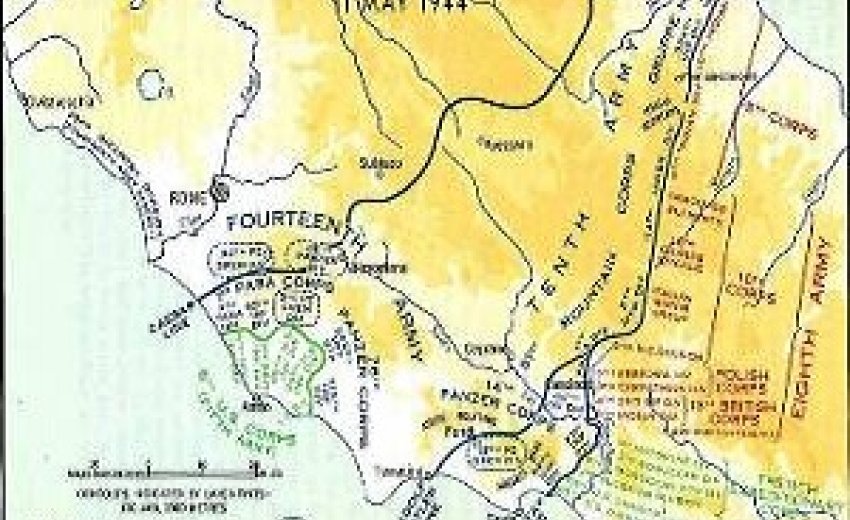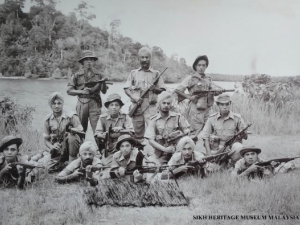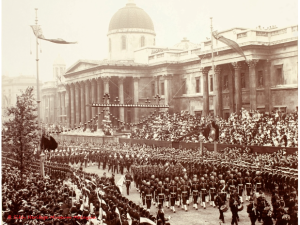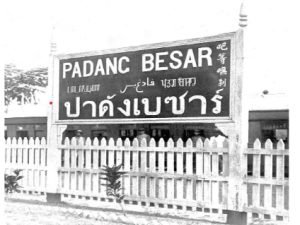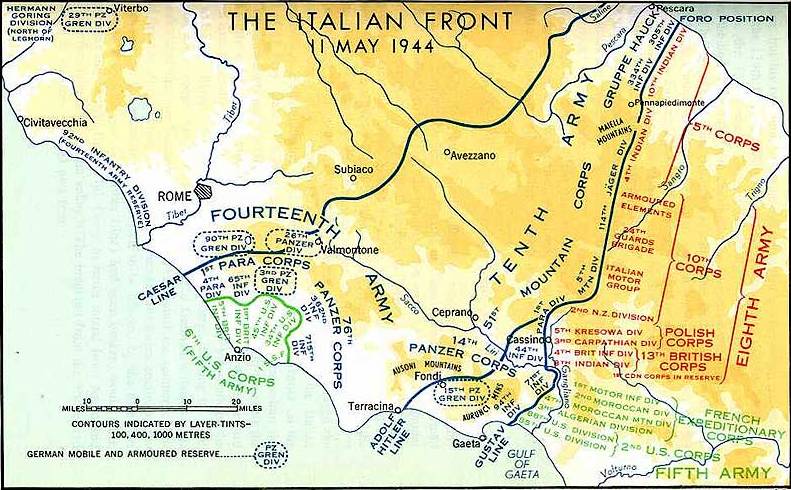
THE SIGNIFICANT CONTRIBUTION OF THE SIKHS DURING THE ITALIAN CAMPAIGN 1943-1945
India made its contribution to the Second World War by providing almost two million volunteers in a couple of years. At the outbreak of the Second World War, in September1939, the Indian Troops, totaled 2,005,038. By 1941, India had recruited 9,000,000 soldiers. By August 1945 two million volunteer soldiers were fighting in Africa, Sidi Barrani, Alam El Halfa and El Alamein. In Italy, Indian Forces were deployed in Cassino, Sangro and on the Gothic Line.
In Italy, more than half of the country saw the Sikhs fighting against the Germans right from the first assault on the Gothic Line in August 1944, to the last assault on the Senio River in April 1945. During these months the Eighth British Army included the Fourth and Tenth Indian Divisions. These Indian Divisions had the famous Gurkha and Sikh Regiments who had been serving the British Empire for a Century.
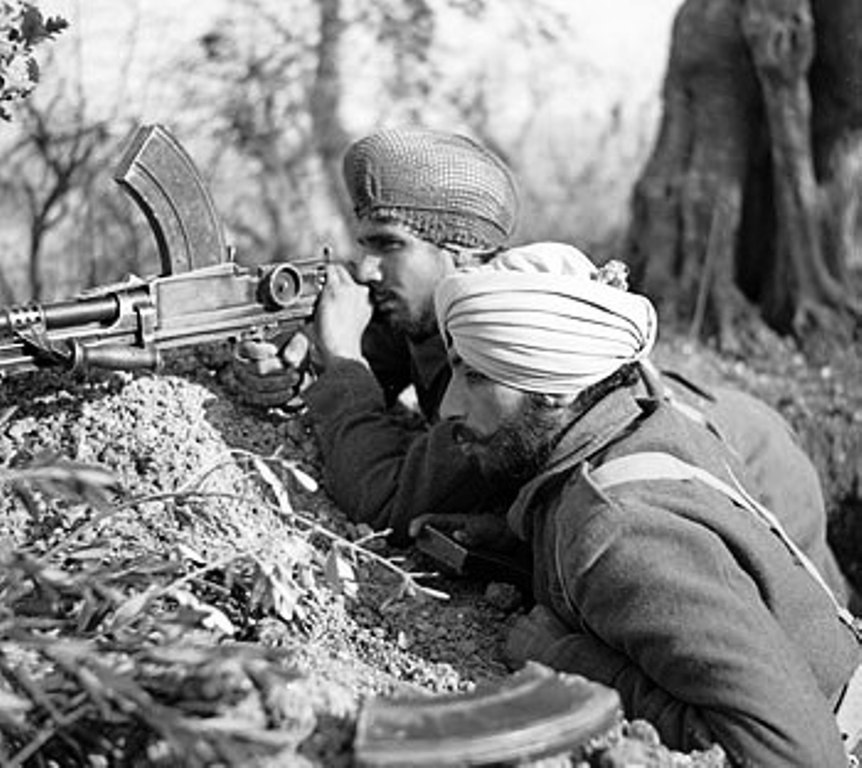
Almost 50,000 troops, mostly between the ages of 19 and 22, fought for the sake of freedom in Italy. Close to 50 per cent of them were injured in the process. Of these, a total of 5782 Indian soldiers died in Italy. It is to their credit that out of twenty Victoria Cross decorations given for bravery during the war in Italy, the Indian soldiers received as many as six.
It is unfortunate that the major contribution of the three Indian Army Infantry Divisions, 4, 8 and 10 and the 43 Gurkha Infantry Brigade has been given such short shrift in the annals of war, this despite the fact that the war correspondent of the Illustrated London News has categorically stated that at the end of the Italian Campaign on VE Day 1945, 8th Indian Division was perhaps the best fighting formation in Italy. The story of their bravery and their sacrifice is still talked about in Italian cities and villages that they helped to liberate. However, the full account of their bravery is not available to the wider public.
Some Interesting Anecdotes.
The landing of Allies in Sicily on 09 July 1943 marked the commencement of the Italian Campaign. The landings signified the decline of Fascism and Italy joining the war on the side of Allies. The liberation of Ferrara was officially announced by the Anglo-American troops at 0730 hours on 24 April 1945. According to the testimonies of that time, Indian troops were among the first to reach Ferrara. They were part of the 5th Corps of the 8th British Army and were composed mainly by Sikh soldiers. After the liberation of Ferrara, these troops were deployed in Porotto, on the way leading to the Po River which ran along the Gothic Line.
Not many historic or photographic records exist regarding the contribution of Indian troops in the capture of Ferrara. The most evident sign of Indian presence in Ferrara is represented by the War Cemetery of Ravenna, Argenta and especially by the one in Forli. The cemetery in Forli also has a Cremation Memorial commemorating the Hindu and Sikh soldiers and officers who died in Italy during this period, from 16 April 1944 till the end of the war.
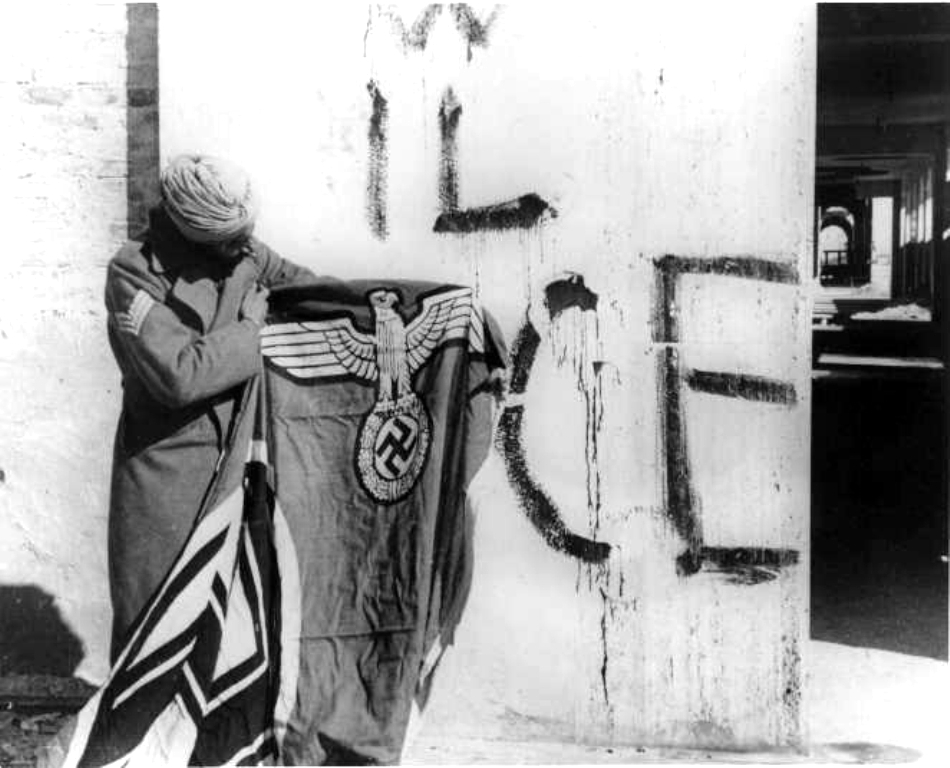
The Fourth Indian Division was the first one to advance against the Gothic Line at 6 AM on 25 August, 1944 on Acqualagna - Fermignano - Urbino axis. It was the internal axis and it was also far from the sea, on the extreme left of the allied deployment. Thus, it was the hardest axis to advance on and to get to Romagna. The Gurkhas captured Auditore on 3rd September, 1944. The day after, in Poggio San Giovanni, Havildar (Sergeant) Sham Singh of the 2nd Battalion, 11 Sikh Regiment successfully captured a German machine gun position and four of its crew on his own.
While the 4th Indian Division was fighting on the mountains close to Rimini, the 10th Division went up Tuscany and Catenaia Alps, towards Meldola and Forli to penetrate the defences of Romagna. On 5 October, 1944, Lance Naik (Corporal) Bhuri Singh of the 1st Battalion, 2nd Punjab Regiment assaulted a German trench which was protected by antitank weapons. On 10th October, 1944, another unit of the the 10th Division, the 18th Royal Garhwal Rifles, was very close to Cesena. A platoon was ordered to clear the enemy from the village of Ardiano. Havildar Murti Singh Rawat led his platoon successfully and cleared the village taking 11 German soldiers as prisoners.
On 14 December, 25th Indian Brigade of the 10th Division deployed in South of Faenza, came under counter attack from 90th German Panzer grenadier. During the Counter attack, Lance Naik Ratan Singh Rana, 18th Royal Garwhal Rifles, rescued a wounded officer, under heavy enemy bombardment. The 4th Indian Division distinguished itself again in Ravenna in April 1944 while crossing the Senio River. On 9 April, Naik Samer Singh of the 15 Punjab, crossed the river under enemy fire after three officers had been killed.
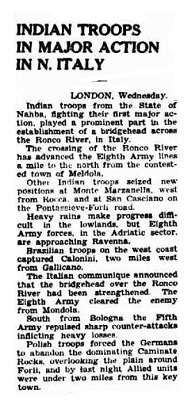 On night 10-11 April, 1944, during the assault on Scolo Tratturo, Naik Mohd Sadiq of 8th Punjab, charged a machine gun position and captured it.
On night 10-11 April, 1944, during the assault on Scolo Tratturo, Naik Mohd Sadiq of 8th Punjab, charged a machine gun position and captured it.
On 3 April, the Eighth Division launched the final offensive. Two platoons of the 4th Battalion, 13th Frontier Force Rifle Regiment, attacked Poggiolo, in Imola area at 22 00 hours. The German infantry was well entrenched and protected by mines and barbed wire. The 6th Platoon launched a frontal attack. The Jemadar (lieutenant) Milkhi Ram cut the barbed wire off so that his platoon could assault despite the direct fire of German mortars and small arms. The last effort. Entire Romagna felt grateful.
"The Fourth, Eighth and Tenth Indian Divisions will forever be associated with the fighting for Cassino, the capture of Rome, the Arno Valley, the liberation of Florence and the breaking of the Gothic Line.
The Spoon River, where the Sikhs fought on the Emilia Romagna territory, has an exotic sound which still evokes the memories of the eastern hemisphere.
The Indian forces though limited to the strength of 4, 8 and 10 Indian Division, distinguished themselves for courage and tenacity in the battles of the Sangro, Cassino, the Liri Valley, the Gothic line, the Senio and several other engagements. The Indian soldiers fought in a terrain that was ideally suited for defence and the offensive proceeded against the grain of the country. Yet they fought with unparalleled courage and relentless tenacity. Within the cemetery will be found the SANGRO RIVER CREMATION MEMORIAL, one of three memorials erected in Italy to officers and men of the Indian forces whose remains were cremated in accordance with their faith - the other two cremation memorials are in Forli Indian Army War Cemetery and Rimini Gurkha War Cemetery.
The memorial at Sangro River commemorates 517 Indian servicemen who fell in 1943-44.Out of it, 237 Volunteers carried the surname "SINGH" The memorial at Cassino commemorates 1,438 Indian servicemen who fell in which, 377 Volunteers carried the surname "SINGH". The cremation memorial at Forli commemorates 769 Indian servicemen in which 370 Volunteers carried the surname "SINGH". HARCHAND SINGH BEDI MALAYSIA

